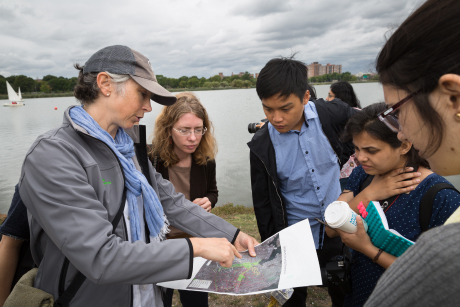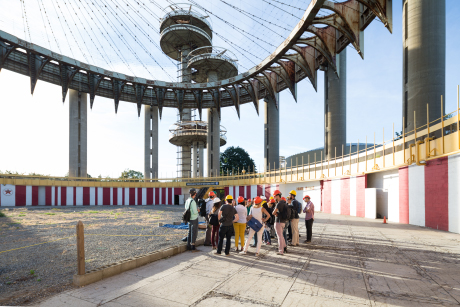Planning the future of past World's Fair sites
By Rebecca Bowes


A group of 29 students converged Sept. 12-13 on one of New York City's most notable, but often underappreciated, landmarks: Flushing Meadows Corona Park in Queens.
City and regional planning (CRP) students in assistant professor Jennifer Minner’s Special Topics in Urban Design course at the College of Architecture, Art and Planning (AAP) and graduate students in AAP NYC’s New York City Urban Planning Workshop met to tour the park and imagine future possibilities for the historic New York State Pavilion and surrounding parklands. Robert Balder ’89, executive director of AAP NYC and a visiting lecturer in CRP, leads the graduate workshop.
Using Flushing Meadows Corona Park and other ’60s-era World's Fair venues, such as HemisFair Park in San Antonio and sites in Seattle and Montreal, Minner and her students are examining the remnants of modernist design and planning and how best to steward and adapt the large-scale, mid-20th century sites across the country. Her class will provide recommendations for the Flushing Meadows site in a final report at the end of the semester to the New York City Parks Department and community advocacy groups.
“Our goal is to identify a type of ‘sustainable adaptation’ that can be applied to a range of sites,” Minner says.
Experiencing a World’s Fair site firsthand gave students an opportunity to consider its past, present and future uses. Minner and Balder arranged a series of tours with New York City Parks officials, including Janice Melnick, administrator for Flushing Meadows Corona Park; Marit Larson, director of wetlands restoration; and John Krawchuk, director of historic preservation, who led students on a hardhat tour inside the crumbling New York State Pavilion.
Krawchuk’s tour “revealed historical nuances that brought us back to a time when the eyes of the world were on New York City,” Balder says.
“The site was bigger and more disconnected than I had imagined. I had no idea that [the park] would be so dependent on the automobile,” says Isaac Robb, MRP ’15.
“Perceptions of the park change depending on who you ask,” Hector Chang ’15 says. “People who live near the park love how it is right now; it's their community park. However, outsiders may think the park is underused and ‘abandoned’ because the park is huge and not a lot of people visit it. Balancing the two needs – community park and regional attraction/recreation center – will be an interesting aspect of the project.”
Matthew Silva, co-founder of People for the Pavilion, which advocates for the restoration of the New York State Pavilion, gave students a preview screening of his documentary, “Modern Ruin: A World's Fair Pavilion.”
“He challenged students to think about ways to breathe new life into the monument … a message that can be applied to many other sites in many other cities across America,” Balder says.
Balder’s AAP NYC students focused on specific aspects of the sites from history to hydrology and will contribute to the final report. Students in visiting lecturer Nathaniel Guest’s course on neighborhood conservation and preservation economics are conducting market and feasibility analyses for adaptive reuse of pavilions in Flushing Meadows and HemisFair Park.
“My hope is that this project will foster a long-term interest among students,” Minner says, “and that they will go on to careers where they can not only address some of these large-scale projects from the past, but also propose designs for new sites that take the need for ongoing stewardship and adaptation into account.”
The trip was partially funded by a grant from Cornell’s Engaged Learning + Research Center.
Rebecca Bowes is a writer in the College of Architecture, Art and Planning.
Media Contact
Get Cornell news delivered right to your inbox.
Subscribe